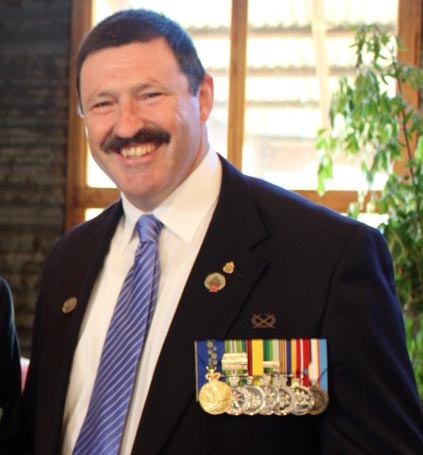The force which began arriving in April 1966 was known as 1 Australian Task Force (1ATF). It was based at Nui Dat in Phuoc Tuy Province, east of Saigon. A support group, the 1st Australian Logistical Support Group (1ALSG) was also established at the port of Vung Tau.

Headquarters Company, 1st Australian Task Force (HQ Coy, 1 ATF) and its sub unit, Defence & Employment (D&E) Platoon were formed in the early months of 1966 from elements of various units including 8 & 12 Platoons, "C" Company, 7 RAR at Puckapunyal, Victoria, and transferred to Holsworthy after the Government of the day announced that it was going to send a Task Force to South Vietnam.

For the purposes of this website, concentration is directed mainly to the functionalities of Headquarter Company and Defence & Employment Platoon (D&E). However, as can be seen on the banner on the Home page of this website, various other units also came under the overall and direct command of HQ1ATF.
Headquarters Company
Defence & Employment Platoon
Headquarters Staff
1st Australian Reinforcement Unit
Headquarters Platoon
1st Transport Platoon
Detachment 198 Works Section (RAE)
1st Australian Light Aid Detachment (RAEME)
1st Australian Provost Detachment
Detachment 1st Division Intelligence Section
Detachment 1st Topographical Survey Troop.
(reference: vvaa.org.au/orbat.htm)
This allowed Infantry, Artillary, Armoured and Engineers to operate under their own respective direction. (In layman’s terms, under their own management structure)

Headquarters Company's function in South Vietnam was to provide administrative and logistical support staff to Headquarters, lst Australian Task Force. This included a broad spectrum of specialist staff ranging from Intelligence personnel right through to the paymaster, just to name two categories.

HQ1 ATF also had a platoon of Infantry soldiers, D&E platoon, who in the early days of the Task Force were employed as working parties in building the facilities required by Headquarters of the Task Force.
The platoon also had a key role in the defence of Headquarters, 1 ATF should the Task Force Base at Nui Dat be invaded. Their role was to provide a last line defence to the Headquarters area including the vital telecommunications area of the Base.

Whenever Task Force Headquarters moved into the field, D&E platoon provided its perimeter defence. The first occasion of this happening was Operation "Hayman" on 6 November 1966, which also saw the first large scale aerial insertion onto unsecured landing zones, of the Task Force, on Long Son Island. D&E platoon were also present at the Battle of Fire Support Base "Coral" in May 1968. Again on 5 June 1971, Task Force Headquarters moved to "Courtenay Hill" which had been previously secured by D&E platoon, following the withdrawal of a company of 2 RAR, to conduct Operation "Overlord" and the battle of Long Khanh. This was possibly the last time that the Task Force established a forward headquarters out of the Base.

D&E platoon's role altered over the many years that Australians were present in South Vietnam. As an Infantry platoon of 3 sections of about 36 to 40 soldiers, it become an extra resource available for use by the Task Force Commander. In 1970-71, it became the "eyes and ears" of the Task Force out in the field and gathered first hand intelligence that the Task Force used to plan operations. It was the Task Force's Recce (reconnaisance) platoon and carried out "long range" patrols at times to gather such information during its normal operations. As such, it was equipped appropriately.

Defence & Employment platoon, lst Australian Task Force, was the longest continually serving Infantry platoon in South Vietnam, being continually reinforced through the lst Australian Reinforcement Unit, and was only removed from the Order of Battle when the lst Australian Task Force withdrew from Nui Dat to Vung Tau in late 1971.
Headquarters, 1ATF had as it's emblem a red kangaroo on a yellow shield bordered by green, and was affectionately known by the soldiers as the "Red Rat".

Our Patron

The Hon.Dr. Mike Kelly AM. MP. (ret.Col)
Mike joined the Army in 1987 and has extensive military experience including a number of operational deployments, finishing his career at the rank of Colonel. He served in Somalia (for which he was awarded the Chief of the General Staff’s Commendation and made a Member of the Order of Australia); and was seconded to the International Committee of the Red Cross in Bosnia Herzegovina and Croatia. He deployed on a successful hostage recovery mission to Kenya; and was a member of the UN Peacekeeping Force in East Timor, where he was awarded the Force Commander’s Commendation. He also served with the Coalition Provisional Authority in Iraq from 2003-2004. His last full posting with the Army was in Strategy Group where he was involved in the management of the 2006 crises in Timor Leste and Lebanon.
Mike was elected to Federal Parliament at the 2007 federal election winning the seat of Eden Monaro, and was appointed Parliamentary Secretary for Defence Support in the incoming Rudd Government. In 2009 he was also appointed Parliamentary Secretary for Water.
Mike retained his seat in the 2010 federal election. As a result of the re-elected Labor Government's regional focus, Kelly was appointed as Parliamentary Secretary for Agriculture, Fisheries and Forestry in September 2010, but in December 2010 he was appointed as Parliamentary Secretary for Defence in a Government reshuffle.
In a third reshuffle in early 2013, Mike replaced Jason Clare as Minister for Defence Materiel.
At the 2013 Federal election, Mike lost his seat to the Liberal Party candidate. Mike won back his Federal seat of Eden-Monaro at the 2016 elections. He retired from politics on 30 April 2020, due to ill health, caused by medical issues during his various services outside of Australia.



